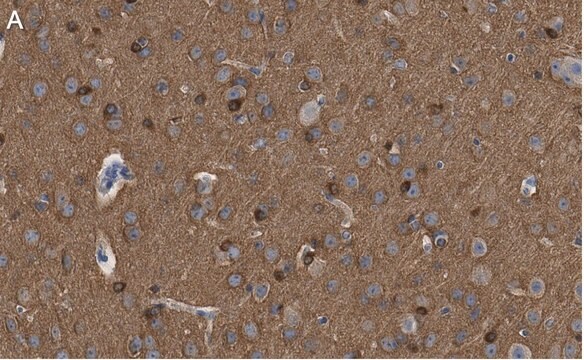Nuclear staining in mice has not been observed with this antibody. The immunohistochemistry images provided show cytoplasmic staining of glial cells, extracellular matrix staining of mouse cerebral cortex, membrane and cytoplasmic staining of tubule epithelial cells and podocytes in glomeruli of mouse kidney, and cytoplasmic staining of neurons in the muscular layer of mouse small intestine tissues. Mouse tau antibodies have not been validated for nuclear localization.
MABN827
Anti Tau (MAPT) Antibody (not human)
mouse monoclonal, T49
Synonym(e):
Microtubule-associated protein tau, Neurofibrillary tangle protein, Paired helical filament-tau, PHF-tau
About This Item
Empfohlene Produkte
Produktbezeichnung
Anti-Tau Antibody, clone T49 (Not human), clone T49, from mouse
Biologische Quelle
mouse
Qualitätsniveau
Antikörperform
purified antibody
Antikörper-Produkttyp
primary antibodies
Klon
T49, monoclonal
Speziesreaktivität
mouse, rat, bovine
Darf nicht reagieren mit
human
Methode(n)
immunohistochemistry: suitable
western blot: suitable
Isotyp
IgG1κ
NCBI-Hinterlegungsnummer
UniProt-Hinterlegungsnummer
Versandbedingung
wet ice
Posttranslationale Modifikation Target
unmodified
Angaben zum Gen
human ... MAPT(4137)
mouse ... Mapt(17762) , Mapt(281296)
rat ... Mapt(29477)
Allgemeine Beschreibung
Immunogen
Anwendung
Western Blotting Analysis: A representative lot detected Tau in PS19 neurons treated with PBS or transduced with strain A or strain B FL a-syn pffs (Guo, J.L., et al. (2013). Cell. 154:103-117).
Qualität
Western Blotting Analysis: 0.5 µg/mL of this antibody detected Tau in 10 µg of mouse and human brain tissue lysate.
Zielbeschreibung
Physikalische Form
Sonstige Hinweise
Sie haben nicht das passende Produkt gefunden?
Probieren Sie unser Produkt-Auswahlhilfe. aus.
Lagerklassenschlüssel
12 - Non Combustible Liquids
WGK
WGK 1
Flammpunkt (°F)
Not applicable
Flammpunkt (°C)
Not applicable
Analysenzertifikate (COA)
Suchen Sie nach Analysenzertifikate (COA), indem Sie die Lot-/Chargennummer des Produkts eingeben. Lot- und Chargennummern sind auf dem Produktetikett hinter den Wörtern ‘Lot’ oder ‘Batch’ (Lot oder Charge) zu finden.
Besitzen Sie dieses Produkt bereits?
In der Dokumentenbibliothek finden Sie die Dokumentation zu den Produkten, die Sie kürzlich erworben haben.
-
Can nucleolar murine tau be detected using this antibody? Do you have an antibody that does detect nucleus-localized murine tau?
1 answer-
Helpful?
-
Active Filters
Unser Team von Wissenschaftlern verfügt über Erfahrung in allen Forschungsbereichen einschließlich Life Science, Materialwissenschaften, chemischer Synthese, Chromatographie, Analytik und vielen mehr..
Setzen Sie sich mit dem technischen Dienst in Verbindung.







